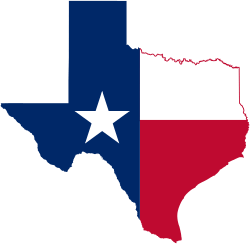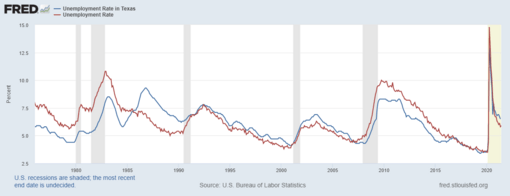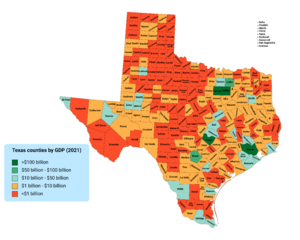Economy of Texas facts for kids
 |
|
| Statistics | |
|---|---|
| GDP | $2.6 trillion (2023) |
|
GDP per capita
|
$86,431 (2023) |
|
Population below poverty line
|
14.0% (absolute) 11.3% (relative) |
| 0.4796 | |
|
Labor force
|
15,226,787 (Apr. 2024) |
| Unemployment | 4.0% (Apr. 2024) |
| Public finances | |
| Revenues | $269.7 billion (2023) |
| Expenses | $258.8 billion (2023) |
The economy of Texas is the second largest in the United States. It has a total value of $2.636 trillion as of 2023. This value is called the gross state product (GSP). In 2022, Texas had the most companies on the Fortune 500 list, with 53 in total. The Fortune 500 lists the largest companies in the U.S. by their earnings.
As of 2023, Texas earned over $440 billion a year from exports. This is more than double the amount of the next highest state, California. If Texas were a country, its economy would be the 8th largest in the world. It would be bigger than the economies of Canada or South Korea.
Contents
History of Texas's Economy
Texas's economy has changed a lot over time. Before World War II, four main industries were very important. These were cattle, cotton, timber, and oil.
Early Industries
The first big success was the cattle industry. In the early days, people mostly used cattle for furs and hides. But soon, Texas started to lead the beef industry. This business did very well in the late 1870s and 1880s.
Cotton farming also grew steadily in Texas. By the early 1900s, Texas was the top cotton producer in the country. However, by the 1920s, the cotton industry started to slow down. This was due to new rules and competition from other countries.
The large forests in East Texas were also very important. They provided a lot of wood for settlers. When railroads were built in the mid-1800s, the lumber business boomed. This lasted for about 50 years. It ended when many forests were cut down and the Great Depression hit.
The Oil Boom
In 1901, a company found a huge amount of oil at Spindletop in Beaumont. This was the biggest oil discovery the world had ever seen. It led to a lot of oil exploration across Texas. By 1940, Texas was the top oil producer in the U.S.
Texas was mostly rural until World War II. But the oil industry helped the economy grow quickly. Many types of heavy industries started up. The war created a huge need for oil and other products that Texas could provide. By the end of the war, Texas was a leading industrial state. Most of its people lived in cities. The economy also became more diverse, meaning it had many different types of businesses.
Today, Texas's economy relies on many things. These include technology, oil and natural gas, aerospace, defense, and healthcare. It also includes farming and manufacturing.
Texas Exports
Texas has been the top state for exports in the U.S. since 2001. In 2023, it earned over $440 billion from selling goods to other countries.
Here are the largest export categories from Texas in 2023:
- Oil and gas – $140 billion
- Petroleum and coal products - $70 billion
- Chemicals - $58 billion
- Computer and electronic parts - $53 billion
- Transportation equipment - $27 billion
Mexico is the biggest buyer of Texas goods. In 2023, Mexico bought nearly $130 billion worth of goods. Canada and the Netherlands are also big export partners.
The Port of Houston is the largest port in the U.S. by the amount of cargo it handles. More than 266 million tons of goods passed through it in 2021.
Taxes in Texas
Texas has some of the lowest state and local taxes in the country. It ranks as the 7th lowest nationally. Texans pay about $3,580 per person in state and local taxes each year. This is about 8.7% of their income.
Texas is one of only seven states that does not have a state income tax. This means people don't pay a tax on their earnings to the state government. The state sales tax rate is 6.25%. Local areas can add up to 2% more, making the total sales tax up to 8.25%. There is also a "back to school" sales tax holiday once a year. During this time, clothing and footwear under $100 are tax-free.
Property taxes are collected only by local governments in Texas. These taxes are usually higher than the national average. However, the cost of property itself is often lower.
Key Industries in Texas
Texas has many important industries that help its economy grow.
Agriculture
Texas has the most farms and farmland of all U.S. states. It leads the nation in the number of cattle, usually over 16 million. Texas is also the top producer of sheep and goat products.
Cotton is the leading crop in Texas. It is the second most valuable farm product. Texas also grows a lot of cereal crops. Three counties in the state grow rice, making up about 5% of the U.S. rice production. Texas is also a big producer of watermelons, grapefruits, and cantaloupes. The Rio Grande valley is especially good for growing grapefruit.
Farmers in Texas also grow grapes, strawberries, spinach, and onions. Many different crops are grown across the state.
Aeronautics
The Lyndon B. Johnson Space Center (NASA) is in Houston. It is a major center for the space industry. The National Space and Biomedical Research Institute is also in Houston.
Dallas/Fort Worth International Airport is the largest airport in Texas. It is the second largest in the U.S. and fourth largest in the world. It is a main hub for American Airlines, one of the world's largest airlines. George Bush Intercontinental Airport in Houston is Texas's second-largest airport. It is a main hub for United Airlines.
Many important aviation companies are based in Texas. American Airlines is headquartered in Fort Worth. Southwest Airlines is based in Dallas. Lockheed Martin Aeronautics, which makes fighter jets like the F-16 and F-35, is also in Fort Worth. Bell Helicopter is another major company based there.
Defense
Texas is home to several large military bases. Fort Cavazos and Fort Bliss are two of the largest U.S. Army facilities. Fort Sam Houston in San Antonio has a major Army hospital. The Corpus Christi Army Depot is the world's largest helicopter repair facility.
The United States Air Force has several bases in Texas, including Sheppard, Dyess, and Lackland Air Force Bases. The United States Navy also operates bases like Naval Air Station Joint Reserve Base Fort Worth.
Many defense companies have offices and factories in Texas. These companies create many jobs. For example, Lockheed Martin makes fighter jets in Fort Worth. Bell Helicopter Textron makes military helicopters. Other major defense companies like Boeing and Raytheon also have a presence in the state.
Computer Technology
Texas is a big center for computer technology. This includes making computer parts, systems, and software. Austin, Dallas, and Houston are the main centers for this industry. Austin is sometimes called "Silicon Hills" because many computer chip design companies are there. These include AMD and Intel.
Dell's headquarters is in Round Rock, near Austin. Large offices for Google, Facebook, and Apple are also in the Austin area. Dallas is known as the "Telecom Corridor" or "Silicon Prairie." This is because many technology companies like Texas Instruments are located there.
Energy
Energy is a huge part of Texas's economy. Texas uses the most energy in the nation. It also produces the most energy, twice as much as the next highest state. Texas is also the national leader in wind power. In 2019, about 28% of the nation's wind electricity came from Texas.
Tourism
Texas has a large tourism industry. The state's tourism slogan is "Texas: It's like a whole other country." Tourists can enjoy the Hispanic culture in San Antonio and El Paso. They can also visit western attractions in Fort Worth.
Coastal areas like Galveston, Corpus Christi, and Padre Island are popular beach spots. Houston and Dallas are leading cities for conventions and events. Professional and college sports are also very popular in Dallas and Houston.
Entertainment
Texas is a top state for filmmaking. Austin is now one of the leading places for movies and TV shows. The popular TV show Dallas was filmed at Southfork Ranch in Parker, Texas. From 1995 to 2004, over $2.75 billion was spent on film and TV production in Texas.
The Texas Film Commission helps filmmakers find locations and resources. Many Hollywood studios are also moving parts of their production to Austin, Houston, and Dallas. Video game companies like Gearbox Software are based in the Dallas Fort Worth area.
Healthcare
Healthcare is a growing industry in Texas. The Texas Medical Center in Houston is the largest medical center in the world. It includes the University of Texas M.D. Anderson Cancer Center, a global leader in cancer research. The Baylor College of Medicine is also located there.
The University of Texas has medical branches in Dallas, San Antonio, and Galveston. The South Texas Medical Center in San Antonio has a big economic impact on the state. Texas has a total of nine medical research centers.
Wealthiest Places in Texas
This list shows some of the wealthiest places in Texas based on how much money people earn there:
- Southlake, Texas – $176,427 per person
- Barton Creek – $110,504 per person
- Westover Hills – $98,573 per person
- Highland Park – $97,008 per person
- Midland – $93,369 per person
- Hunters Creek Village – $88,821 per person
- Bunker Hill Village – $86,434 per person
- Hill Country Village – $77,374 per person
- Mustang – $75,692 per person
- West University Place – $69,674 per person
- Hilshire Village – $66,620 per person
- Olmos Park – $65,697 per person
- The Woodlands – $64,430 per person
- University Park – $63,414 per person
- The Hills – $61,363 per person
- Southside Place – $57,021 per person
- West Lake Hills – $55,651 per person
- Onion Creek – $54,758 per person
- Tiki Island – $54,611 per person
- Parker – $54,099 per person
- Lakeshore Gardens-Hidden Acres – $52,512 per person
- Rollingwood – $52,280 per person
- Hedwig Village – $52,153 per person
- Lost Creek – $52,147 per person
- Heath – $51,049 per person
- Colleyville – $50,418 per person
- Shavano Park – $47,705 per person
- Sugar Land – $47,597 per person
- Bellaire – $46,674 per person
- Lakeway – $45,765 per person
- Ransom Canyon – $45,675 per person
- Alamo Heights – $45,640 per person
Images for kids














